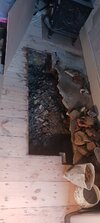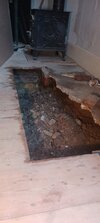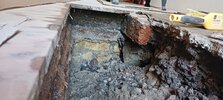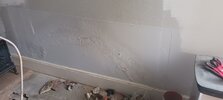Hi All,
I’m hoping someone might be able to help with an issue of dampness around a fireplace hearth that I’m currently trying to resolve. I have taken various bits of info/advice from here before and I’m back now to post for the first time so any help would be much appreciated. I have also read the ‘Another Damp Hearth’ thread from July 2017 and would like to confirm that what I am going to do as a result of that is correct.
To summarise, a chimney breast in our Edwardian house was removed by a previous owner and we find that the floorboards butting up against the old concrete hearth show signs of getting damp after anything more than a light rain shower. This wouldn’t be visible if we had carpet etc but is a problem as we will be having exposed wood floors. We’ve checked guttering near the affected areas and have replaced anything broken so are pretty confident it isn’t caused by this. The next thought is moisture from groundwater rising from the base of the chimney hearth structure. Having removed part of the concrete base that sits on top of the stack i.e. what forms part of the living room floor, the stack is full of rubble and general backfill. Sitting on top of the hearth just below the floorboards are two wooden supports which the floorboards sit on. As I assume there is no damp proof membrane in the hearth structure these are very wet to the touch to the extent that I could almost pull them apart with my fingers.
The question is how to resolve all of this. I’m thinking I need to remove as much of the backfill as possible as well as the damp wooden supports between the hearth and floorboards. Then put a damp proof membrane on the top row of bricks on the stack before replacing the wooden supports. These are marginally bigger than 2x4s so I assume I would need to add shims somewhere to replicate the original height. As we plan to extend the floorboards over what was originally the concrete hearth I assume I will also need to add two supporting joists, one on the wall and one running across the middle of the stack. As you can see in one picture the wall at the back of what was the original fireplace also shows signs of damp. If I understand correctly, this is because salts have formed in the brickwork / plaster from when the fireplace was in use and these now draw moisture up before it is drawn out into the living room. To fix this I assume I need to remove plaster back to the brickwork, extend the damp proof membrane up and then replaster. Is this correct or is there a better fix?
Re. the hearth base, I feel like it would be easier to replace the wooden supports with wood rather than concrete but am not sure how I would go about fixing these to the DPM. Any suggestions? To complicate things further I would ideally like to do this without lifting any of the floorboards….. There is approx. 3 feet of crawl space below so working beneath the floor if required is possible to a certain extent. It will also be me doing the work (If I can) so if things take a bit more time because of keeping the flooring in situ it isn’t an issue.
Apologies if any of the terms I have used are incorrect but hopefully the gist of the problem is clear. Any help would be much appreciated.
I’m hoping someone might be able to help with an issue of dampness around a fireplace hearth that I’m currently trying to resolve. I have taken various bits of info/advice from here before and I’m back now to post for the first time so any help would be much appreciated. I have also read the ‘Another Damp Hearth’ thread from July 2017 and would like to confirm that what I am going to do as a result of that is correct.
To summarise, a chimney breast in our Edwardian house was removed by a previous owner and we find that the floorboards butting up against the old concrete hearth show signs of getting damp after anything more than a light rain shower. This wouldn’t be visible if we had carpet etc but is a problem as we will be having exposed wood floors. We’ve checked guttering near the affected areas and have replaced anything broken so are pretty confident it isn’t caused by this. The next thought is moisture from groundwater rising from the base of the chimney hearth structure. Having removed part of the concrete base that sits on top of the stack i.e. what forms part of the living room floor, the stack is full of rubble and general backfill. Sitting on top of the hearth just below the floorboards are two wooden supports which the floorboards sit on. As I assume there is no damp proof membrane in the hearth structure these are very wet to the touch to the extent that I could almost pull them apart with my fingers.
The question is how to resolve all of this. I’m thinking I need to remove as much of the backfill as possible as well as the damp wooden supports between the hearth and floorboards. Then put a damp proof membrane on the top row of bricks on the stack before replacing the wooden supports. These are marginally bigger than 2x4s so I assume I would need to add shims somewhere to replicate the original height. As we plan to extend the floorboards over what was originally the concrete hearth I assume I will also need to add two supporting joists, one on the wall and one running across the middle of the stack. As you can see in one picture the wall at the back of what was the original fireplace also shows signs of damp. If I understand correctly, this is because salts have formed in the brickwork / plaster from when the fireplace was in use and these now draw moisture up before it is drawn out into the living room. To fix this I assume I need to remove plaster back to the brickwork, extend the damp proof membrane up and then replaster. Is this correct or is there a better fix?
Re. the hearth base, I feel like it would be easier to replace the wooden supports with wood rather than concrete but am not sure how I would go about fixing these to the DPM. Any suggestions? To complicate things further I would ideally like to do this without lifting any of the floorboards….. There is approx. 3 feet of crawl space below so working beneath the floor if required is possible to a certain extent. It will also be me doing the work (If I can) so if things take a bit more time because of keeping the flooring in situ it isn’t an issue.
Apologies if any of the terms I have used are incorrect but hopefully the gist of the problem is clear. Any help would be much appreciated.





